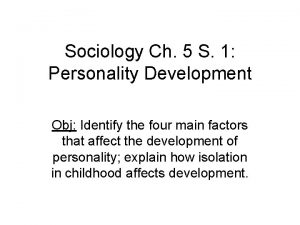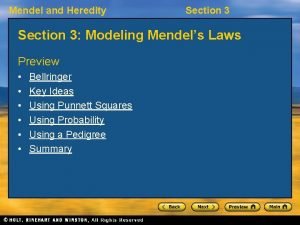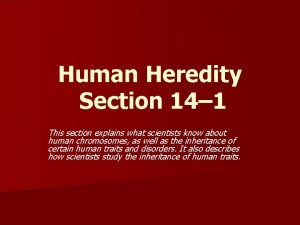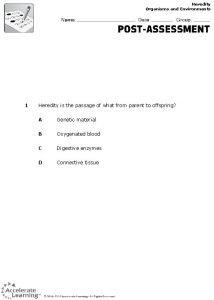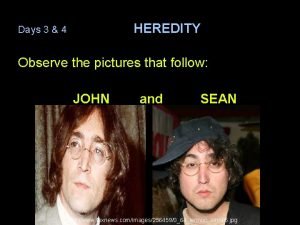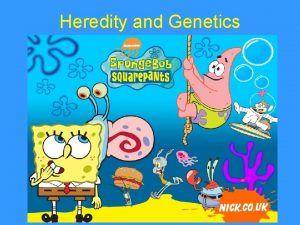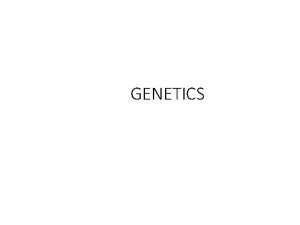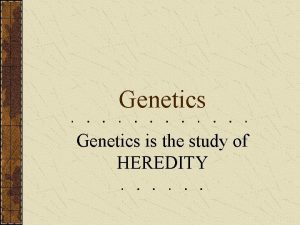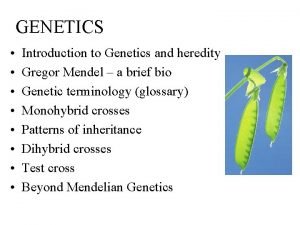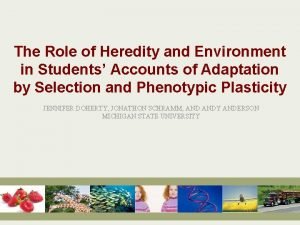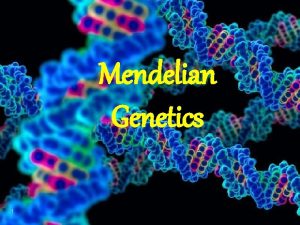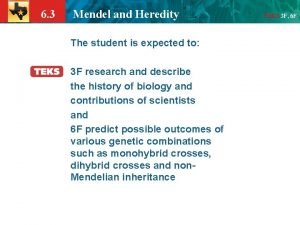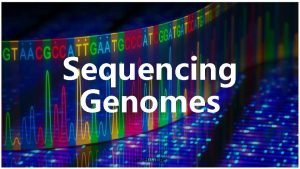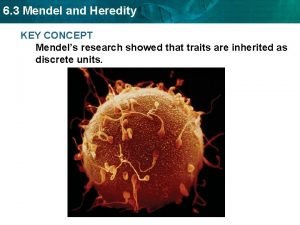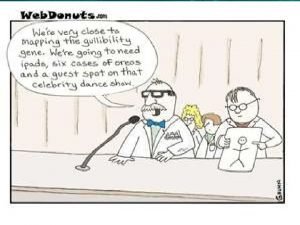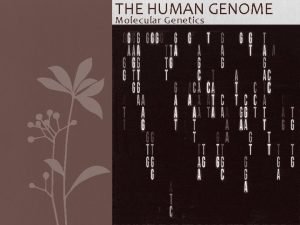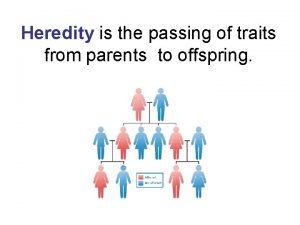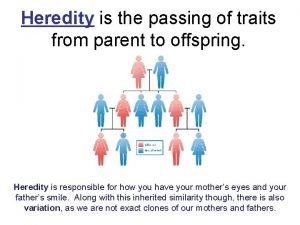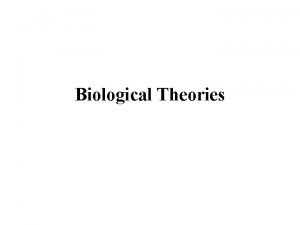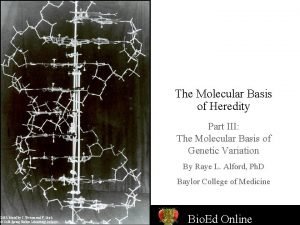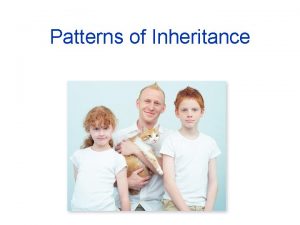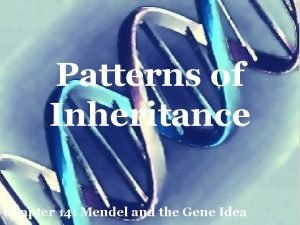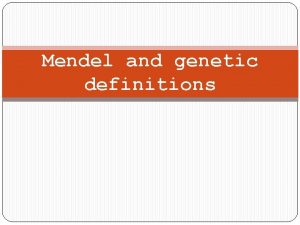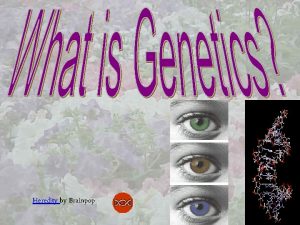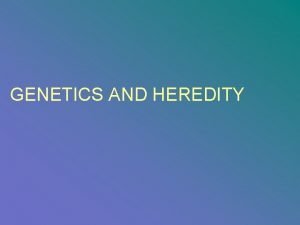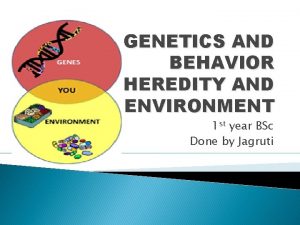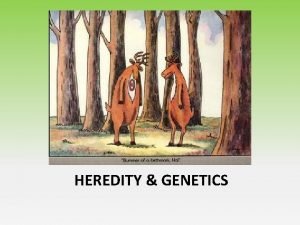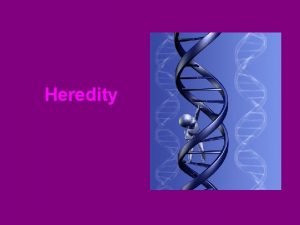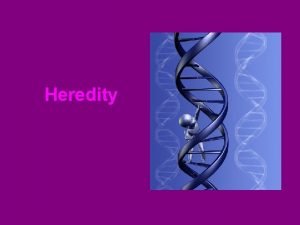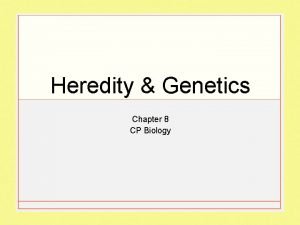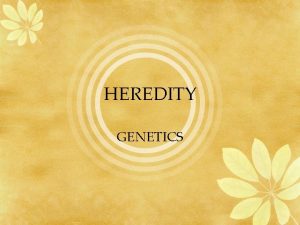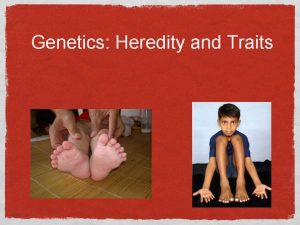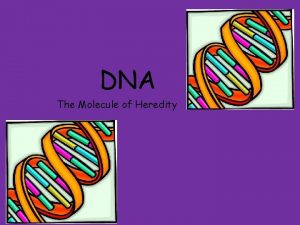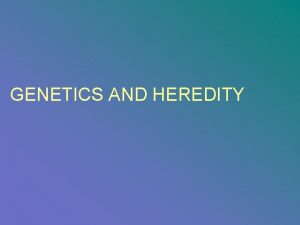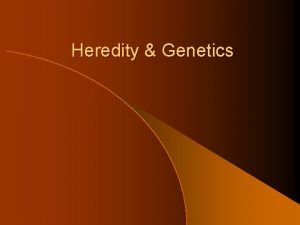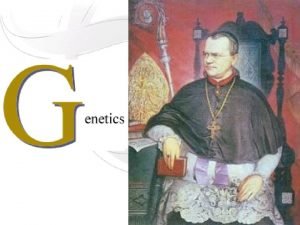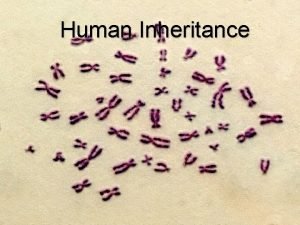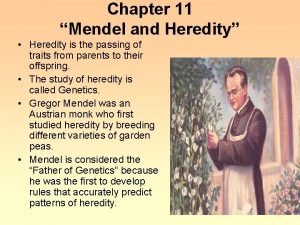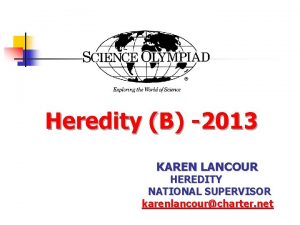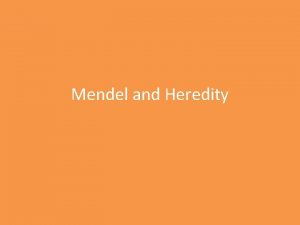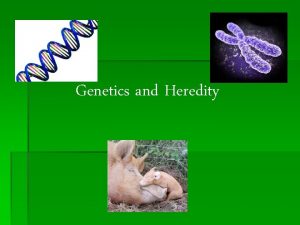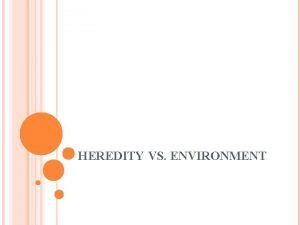Heredity CH 7 PP 1 An introduction Family





































- Slides: 37

Heredity CH 7 – PP 1 An introduction

Family Resemblance

Heredity • The study of inheritance – Genetics • study of mechanism and patterns of inheritance – Gene • Segment of DNA that codes for a specific protein – Genome • Sum of all DNA – Genomics • Study of genomes

Bioinformatics • Using IT to: – Manage large amounts of biological data – Analyse the data • 2003 the Human Genome Project completed mapping the entire human genome – Sequence of base pairs in human DNA – More than three billion pairs

Human Genome Project • Mapped genomes of – Human DNA (a reference genome) – E. Coli – Fruit Fly (Drosophila melanogaster) – Laboratory mouse

Human Genome • 6 billion bases make up your genome – 3 billion pairs – 1 billion codons • 46 chromosomes – 23 pairs

DNA Chromosome • In Eukaryotic organisms, DNA molecules and associated proteins are contained within the nucleus as tangled fibres of chromatin • During division, the long DNA molecules appear as double structures each coiled around histone proteins • In eukaryotes, chromosomes exist as pairs

DNA Chromosome

DNA Chromosome

Shapes of Chromosomes

Chromosome

Chromosome • Telomere – caps the end of the chromatid – Prevents degradation of the DNA – Helps DNA replication

Chromosome • Centromere – Region that divides the chromosome into unequal length arms – Links the two chromatids

Chromosome • Staining chromosomes reveals banding patterns • Pattern is the same in each pair of chromosomes – Homologous chromosomes • Used to manually pair chromosomes

Photos of Human chromosomes

Karyotype • Photographic images of chromosomes are ordered by length, from largest to smallest • Humans have 22 pairs of matched or homologous chromosomes PLUS one pair of sex chromosomes • The number of chromosomes in each somatic (body) cell is called the diploid number 2 n. As chromosomes occurs in pairs, n stands for the number of pairs. Eg Human 2 n =46

Karyotype Autosomes Heterosomes or Sex chromosomes

Karyotype

Numbers of chromosomes • Varies between organisms and is not a measure of the quantity of genetic material – Human 46 (that is 23 pairs) – Chimpanzee 48 – Horse 64 – Dog 78 – Housefly 12 – Cabbage 18 – Potato 48

Sex chromosomes • In humans there is a 50% chance that a sperm carrying a X chromosome OR 50% carrying a Y chromosome will fertilise an egg. • Not always like this in other species • Birds – males are XX, females XY • Some insects females are XX, males XO – only females need matched pair • Bees, females come from fertilised eggs and are diploid, males come from unfertilised eggs and are haploid

Genes • Segment of DNA that directs the formation of a particular structural and functional protein • Vary in size from 8000 to 2 million base pairs • Humans have approx 25, 000 genes • Each gene is found at a particular location on a chromosome called a locus (plural loci)

Inherited Traits

Inherited Traits • Many genes have two or more variations – Alleles • Widow’s Peak has two alleles – Widow’s Peak – Straight hairline

Inherited Traits • You inherit one gene for hairline from each parent • You can inherit – Two genes for Widow’s Peak – Two genes for straight hairline – One gene of each

Inherited Traits • What happens when you inherit one type of allele from each parent? – One allele for straight hairline – One allele for Widow’s Peak

Inherited Traits • What happens when you inherit one type of allele from each parent? e p – One allele for straight hairline ty o – One allele for Widow’s Peak Gen • You have a Widow’s Peak! e p ty o n he P Phenotype = genotype + environmental effects

Inherited Traits • Shorthand way of representing alleles – Widow’s Peak W Straight Hairline w

Inherited Traits Widow’s Peak W Straight Hairline Individual genotypes can be: w Phenotypes WW Widow’s Peak Ww Widow’s Peak ww Straight hairline

Inherited Traits • Widow’s Peak shows up in both W W and W w • Widow’s Peak is said to be Dominant • Straight hairline is said to be Recessive • Having both alleles the same is said to be Homozygous (also called true breeding) • Having both different is said to be Heterozygous (also called a hybrid)

Human Hairline • Widow’s Peak – Autosomal dominant • Straight hairline – Autosomal recessive Explain what this means?

Monohybrid Cross • True breeding Widow’s Peak with straight hairline. P HH X hh H = Widow’s Peak h = straight hairline

Monohybrid Cross • True breeding Widow’s Peak with straight hairline. P F 1 X HH Hh Hh h hh Hh Heterozygous h Hh H H Hh Hh

Monohybrid Cross • Cross two of the F 1 generation F 1 X Hh H Hh h HH Hh Hh hh Genotype ratio HH : Hh : hh 1 : 2 : 1 F 2 HH Hh Hh hh Phenotype ratio Widow’s : Straight 3 : 1

Activitis “Create a Human Karyotype” http: //learn. genetics. utah. edu/content/chromosomes/karyotype/ Then try your hand at diagnosing some genetic diseases on “Diagnose using Karyotypes” http: //www. biology. arizona. edu/human_bio/activities/karyotyping. html Links on Moodle ***plus 9 past exam questions

2006 Exam 2 2007 Exam 2 2011 Exam 2

2008 Exam 2

2009 Exam 2
 Genetic vocabulary worksheet answer key
Genetic vocabulary worksheet answer key Heredity characteristics include body build
Heredity characteristics include body build Mendelian genetics concept map
Mendelian genetics concept map Section 3 mendel and heredity
Section 3 mendel and heredity Section 14-1 human heredity
Section 14-1 human heredity Heredity is best described as
Heredity is best described as Pictures of heredity
Pictures of heredity Heredity examples
Heredity examples Heredity
Heredity ____________ is the study of heredity.
____________ is the study of heredity. Mendel
Mendel Genetics is the study of heredity and variation
Genetics is the study of heredity and variation Chapter 11 human heredity section 11-3
Chapter 11 human heredity section 11-3 Chapter 11 complex inheritance and human heredity test
Chapter 11 complex inheritance and human heredity test Parts of the chromosome
Parts of the chromosome Importance of heredity and environment in education
Importance of heredity and environment in education Section 3 mendel and heredity
Section 3 mendel and heredity Heredity terminology
Heredity terminology The basic units of heredity
The basic units of heredity Extra x
Extra x Mendel 9 3 3 1
Mendel 9 3 3 1 Sanger sequencing
Sanger sequencing Section 3 mendel and heredity
Section 3 mendel and heredity Section 3 mendel and heredity
Section 3 mendel and heredity Heredity
Heredity Flower structure
Flower structure Organisms that reproduce asexually
Organisms that reproduce asexually Heredity and crime
Heredity and crime Cpalms heredity tutorial
Cpalms heredity tutorial Molecular basis of heredity
Molecular basis of heredity Early ideas about heredity
Early ideas about heredity Dice and coin
Dice and coin What is genotype
What is genotype Heredity
Heredity Inherited traits are brainpop
Inherited traits are brainpop Mendelian genetics vocab
Mendelian genetics vocab What is a pheontype
What is a pheontype Heredity and environment slideshare
Heredity and environment slideshare

